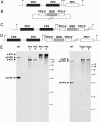Plasmodium falciparum ensures its amino acid supply with multiple acquisition pathways and redundant proteolytic enzyme systems
- PMID: 16731623
- PMCID: PMC1470969
- DOI: 10.1073/pnas.0601876103
Plasmodium falciparum ensures its amino acid supply with multiple acquisition pathways and redundant proteolytic enzyme systems
Abstract
Degradation of host hemoglobin by the human malaria parasite Plasmodium falciparum is a massive metabolic process. What role this degradation plays and whether it is essential for parasite survival have not been established, nor have the roles of the various degradative enzymes been clearly defined. We report that P. falciparum can grow in medium containing a single amino acid (isoleucine, the only amino acid missing from human hemoglobin). In this medium, growth of hemoglobin-degrading enzyme gene knockout lines (missing falcipain-2 and plasmepsins alone or in combination) is impaired. Blockade of plasmepsins with the potent inhibitor pepstatin A has a minimal effect on WT parasite growth but kills falcipain-2 knockout parasites at low concentrations and is even more potent on falcipain-2, plasmepsin I and IV triple knockout parasites. We conclude that: (i) hemoglobin degradation is necessary for parasite survival; (ii) hemoglobin degradation is sufficient to supply most of the parasite's amino acid requirements; (iii) external amino acid acquisition and hemoglobin digestion are partially redundant nutrient pathways; (iv) hemoglobin degradation uses dual protease families with overlapping function; and (v) hemoglobin-degrading plasmepsins are not promising drug targets.
Conflict of interest statement
Conflict of interest statement: No conflicts declared.
Figures




References
-
- Goldberg D. E. In: Malaria: Drugs, Disease, and Post-Genomic Biology. Sullivan D., Krishna S., editors. Berlin: Springer; 2005. pp. 275–291.
-
- Divo A. A., Geary T. G., Davis N. L., Jensen J. B. J. Protozool. 1985;32:59–64. - PubMed
-
- Liu J., Gluzman I. Y., Drew M. E., Goldberg D. E. J. Biol. Chem. 2005;280:1432–1437. - PubMed
Publication types
MeSH terms
Substances
Grants and funding
LinkOut - more resources
Full Text Sources
Other Literature Sources

